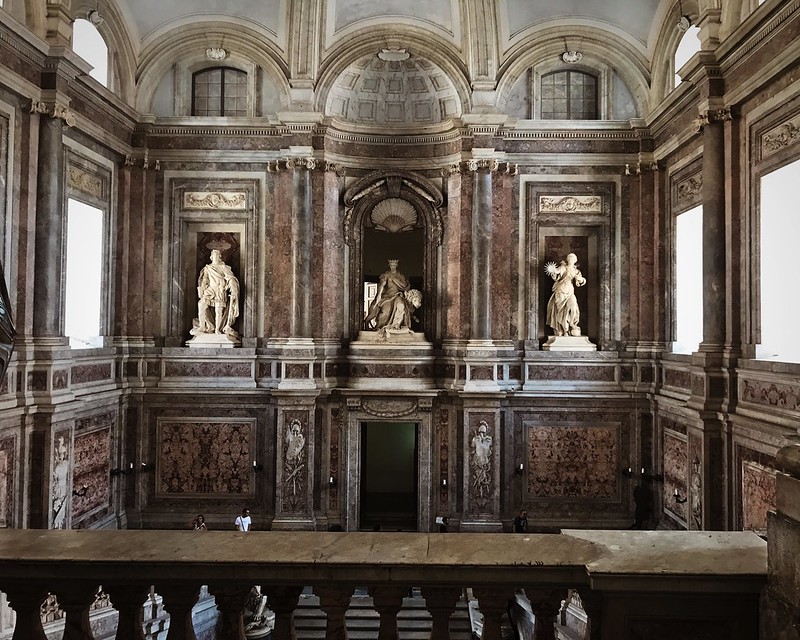It is said that when Charles VII of Naples first set eyes on the scale model of the magnificent royal palace he had commissioned his architect Luigi Vanvitelli to construct for him outside Naples in 1752, the Bourbon king was filled with such emotion that he feared his heart would be torn from his breast.

(Photo by CIUTravel via Flickr)
Though your heart is probably safe, your breath is sure to be taken away by the splendor and opulence of the finished Royal Palace of Caserta (or Reggia di Caserta), a triumph of late Italian Baroque architecture that is stunning both for its massive size and ornate style. The largest royal residence in the world, the palace is often compared to that of Versailles in France—with which it shares a number of stylistic and organizational features—and is a UNESCO World Heritage Site and one of the most visited monuments in southern Italy.
A Palace Fit for a King

(Photo by CIUTravel via Flickr)
Though it was Charles VII who commissioned the palace, his abdication from the Naples throne to take that of Spain just a few years later meant that he never lived in the palace himself, which was instead only partially completed under his third son and successor, Ferdinand IV of Naples. That said, it was Charles who worked with Vanvitelli to create a palace that would serve as a refuge from the urban chaos and political machinations of Naples, just as Versailles did for Louis XIV from Paris. Both palaces also needed to house a king and royal court in the same building in which government business also took place, with an architectural and social plan as complicated as that of a small city, and represent the absolute power and unlimited resources of the monarchy.

(Photo by CIUTravel via Flickr)
The Reggia of Caserta mirrors the Palace of Versailles in form, as well as function. The symmetrical facade features an unbroken line of windows and balustrade along the roof, the internal layout of the rooms includes long enfilades of sumptuous halls, and a large aqueduct was built to provide water for the numerous fountains and water features.

(Photo by CIUTravel via Flickr)
There are important differences between the two palaces, however. At Caserta, there is both the traditional piano reale, or royal floor, and an equally lavish floor just above, giving the palace 40 monumental rooms decorated with frescoes and gold leaf, almost double of those at Versailles. In addition, the Royal Palace of Caserta was inspired by a number of other European palaces—including those of El Escorial, Madrid, and Charlottenburg—and was originally meant to have a vast pair of wings encircling the front courtyard inspired by those of Bernini at St. Peter’s in Rome, which were never completed.
The Royal Palace

(Photo by CIUTravel via Flickr)
Today, the Reggia boasts 1,200 rooms on five floors, including state and royal apartments, the Throne Room, the Palatine Library, the Palatine Chapel, the Royal Staircase, and a theater modelled after the famous Teatro San Carlo in Naples. The rectangle-shaped palace also has four internal courtyards and three atriums in addition to its vast gardens, San Leucio silk factory, and a number of outbuildings and hunting lodges.

(Photo by CIUTravel via Flickr)
The Royal Gardens

(Photo by CIUTravel via Flickr)
Just as spectacular as the palace, the grounds at the Reggia cover almost 300 undulating acres, and are laid out in a Baroque style that emphasizes formal vistas and water features. Beginning at the rear facade of the palace, the garden begins with a long stretch of fountains and waterfalls linked by large basins fed by Vanvitelli’s specially built Acqueduct Carolino, and decorated with statues of figures from Classical Antiquity, including Diana, Venus, and Ceres.

(Photo by CIUTravel via Flickr)
In addition, the grounds include the English Garden, one of the oldest and most important botanical gardens in Europe, the Bosco di San Silvestro woods, and the Belvedere hunting lodge.

(Photo by CIUTravel via Flickr)
The Palace in Wartime
During the Fascist regime, the palace was used to house the Accademia Aeronautica, or Italian Air Force Academy, until being taken over by the Allied forces in October 1943 and becoming their Mediterranean headquarters and a rest center for the US Fifth Army. On April 29, 1945, the terms of the unconditional German surrender of forces in Italy was signed at the Reggia, and later that same year the first Allied war crimes trial of German general Anton Dostler took place here.
The Palace in Hollywood
If you have a slight feeling of deja vù when visiting the Reggia, it may be because it has been used as the setting for a number of blockbuster movies, including Star Wars episodes I and II, Mission Impossible III, Angels and Demons, and Spielberg’s new The Kidnapping of Edgardo Mortara, scheduled for release in 2018.
How to Visit
The Reggia di Caserta is located about 20 kilometers outside of Naples, and can be visited from 8 am to 7:30 pm each day except Tuesday. The grounds close earlier in the winter, due to the shorter days; the English Garden is open for guided tours more or less hourly from 10 am to 4:30 pm. You can tour the ground on foot, rent a bike, take the bus, or opt for a horse-drawn carriage ride.


